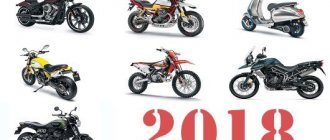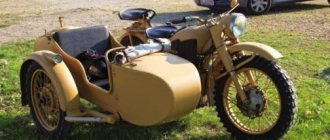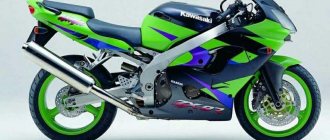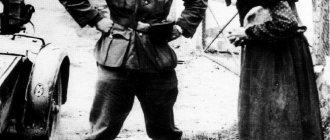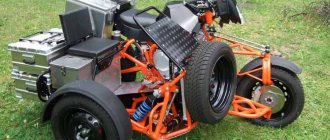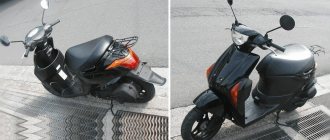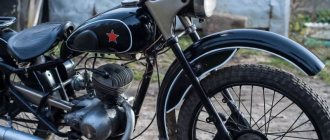Weaknesses and shortcomings of the IZH-P5 engine of the IZH Planet 5 motorcycle
Why did they stop producing the IZH Planet motorcycle in Russia?
Oddly enough, the Kovrov Machine-Building Plant named after Dektyarev (ZID), as well as the former Soviet, now Belarusian Minsk Motorcycle Plant, still supply their motorcycles to the market. As for the Izhevsk Machine-Building Plant, which produces IZH motorcycles (Planet, Planet-Sport, Jupiter), the last production batch of motorcycles was produced in 2008, then, due to difficulties arising from the economic crisis, the production of IZH motorcycles was curtailed. It’s a pity, because the state could have provided assistance to the plant. At that time, Izhmash had a lot of experimental design work on promising motorcycles, both with two-stroke and four-stroke engines. I have a lot of positive memories associated with the IZh “Planet-3” and “Planet-5” motorcycles. Any motorcycle model starting from Planet-2 gave a head start to Jupiters in terms of cross-country ability, old or new, it doesn’t matter.
He didn’t sail on it, even in the taiga or in the forest, fishing or hunting. A very reliable “workhorse” with traction like a tractor, and my father and I never transported anything on it. We bought it in 1989 and to this day my father drives it, but it looks like new and makes my heart happy with its proper operation. Planet motorcycles, even its oldest models, continue to serve their owners regularly and reliably, despite the stoppage of production, there are no problems with spare parts for repairs on the market, and there is no limit to the maintainability stock. In this article, we will look at the IZH-P5 power unit of the IZH Planet 5 motorcycle, or more precisely, its technical characteristics, weaknesses and disadvantages. The IZH-P5 power unit differs from the IZH-P4 20 hp. the previous model of the motorcycle “IZH Planety-4” increased by 2 hp. power, a higher compression ratio and an engine head, the 4th model has two exhaust pipes, the 5th has one. Gearboxes differ in the number of teeth on the gears and, accordingly, in the gear ratios. Gearboxes are interchangeable.
Diesel motorcycle "Dnepr"
Today, such vehicles are nothing less than exotic. They are produced a little around the world, but are not produced on an industrial scale. But thanks to craftsmen and enthusiasts, interesting cars assembled entirely by hand still appear here and there.
For example, when many people see the unit shown below, the question arises about what happened to this motorcycle, what kind of heap of iron it is. What kind of miracle? But in fact, this is not a miracle, but a Dnepr diesel motorcycle.
A designer and lover of motorcycles from a small Ukrainian town in the Chernigov region managed to install a Czech single-cylinder diesel engine on the Dnepr. The engine was two-stroke, with a direct injection system. These motors are known for being often used in a variety of generators, tractors, and compressors.
In Ukraine, such an upgrade will cost equipment lovers 500 US dollars, and if the engine has undergone a factory overhaul, then the price will drop by a third.
Characteristics of the IZH-P5 motor
| engine's type | Single-cylinder, carburetor, two-stroke, air cooled. |
| Working volume, cm 3 | 346 |
| Maximum power, l. With. | 22 (20.9…23.1 at 4850±10% rpm |
| Cylinder diameter, mm | 72 |
| Piston stroke, mm | 85 |
| Compression ratio | 8,2-8,7 |
| Cylinder-piston group lubrication system | mixture of fuel and oil. On later motorcycle models, oil supply is used by an oil pump, which proportions the oil supply depending on the crankshaft speed and engine load in ratios of 1/25-1/100 to the gasoline supply. The filling capacity of the Izh P-5-01 motorcycle engine crankcase is 0.7 l, oil M-8V, M-10V2, MS-14, MS-20, MGD-14M or their foreign analogues. |
| Carburetor | K-65I (in earlier ones - K-62I) |
| Fuel used | motor gasoline with an octane number of at least 76. With a joint lubrication system, gasoline is used in a mixture with motor oils M-8V, M-10V, aviation oil MS-20 in a ratio of 25: 1, or a mixture of gasoline and oil for two-stroke engines MGD-14M (or its foreign analogues) in a ratio of 50:1. |
| Gas tank capacity | 18 l. |
| Air filter | contact-oil |
| Oil filling capacity in the air filter | 0.15 l engine oil |
| Generator | Generator - a three-phase electric machine with electric machine excitation and an electronic rectifier-voltage stabilizer BPV-14-10 (BPV-21-15), with a power of initially 100, then 140 W, or a single-phase generator with excitation from permanent magnets and an electronic regulator RNM-1, power 90 W. |
| Ignition | battery contact capacitor, on later models electronic non-contact, with automatic control of ignition timing based on crankshaft speed and independent of the battery. |
| Spark plug | A23B (or foreign analogues) |
| Accumulator battery | lead acid, type 6MTS-9, 12 volt 9 Ah |
| Transmission | |
| Transfer from engine to clutch | double-row bushing drive chain (reinforced) in an oil bath |
| Clutch | multi-disc in oil bath |
| Gearbox housing filling capacity | 1.0 l, oil M-8V, M-10V2, MS-14, MS-20 or their foreign analogues. |
| Transmission | three-shaft four-speed in one unit with engine and foot gear shift. |
Weaknesses of the IZH-P5 engine
More details about the weak points of the IZH-P5 power unit...
Air filter. To prevent dust from entering the engine, frequent washing and oiling of the filter element is required. Installing a paper filter would reduce the time spent on engine maintenance during maintenance and would improve the quality of cleaning the air supplying the carburetor.
The CPG wears out after 20,000-25,000 km due to the lack of water cooling.
Transmission . Over the years, due to wear and tear, the gears switch off on their own and adjustment does not eliminate the problem. In this case, it is necessary to overhaul the gearbox and replace worn out parts.
Dutch motorcycle on diesel fuel
Beautiful and highly functional turbo-diesel motorcycles Track model “T800Cdi” stand out for their massive popularity on the roads of old Europe.
They are not only produced in mass quantities for the Dutch domestic market, but are also actively exported to many other consumers from different parts of the world. A diesel motorcycle of the above type has won the hearts of the people of Great Britain, and this already says a lot.
The design of the DT bike, its weight, mass and power guaranteed the above two-wheeled bike a high level of popularity among true connoisseurs of motorcycle equipment, in particular those who want the latter to be as economical as possible.
You don’t have to install diesel on Ural and Dnepr motorcycles if you can afford to buy a small Dutch iron horse. Track “T800Cdi” will certainly never disappoint you. It has a very powerful three-cylinder turbodiesel engine. The latest for this brand from the Netherlands was prepared by the world famous. The very use of three “pots” on the engine, and even running on diesel fuel, made this diesel motorcycle unique.
The above power unit has quite high power. Having a working engine volume of 799 cm3, the bike is capable of outperforming gasoline motorcycles many times over. Not to mention the smooth operation and efficiency.
Disadvantages of the IZH-P5 engine
- Loud in operation;
- Increased vibration;
- Oil sprays from the muffler;
- Long acceleration;
- High fuel consumption;
- Small resource;
- Strong return from kickstarter.
Loud operation has a negative impact on people around (interferes with rest), which causes corresponding reactions towards the motorcyclist.
Increased engine vibration is felt throughout the motorcycle, especially with your hands on the handlebars.
Oil splashes from the muffler, which, when driving, falls on the back of the driver or passenger. This disadvantage is eliminated by installing a stainless steel ladle of the appropriate diameter at the end of the exhaust pipe. The ladle should have a sector cut out in advance, which should be in the lower part when mounted with screws. This modification will prevent oil from getting onto the back, and the exhaust will be directed downward.
Long acceleration. Planet 5 with a sidecar takes longer to accelerate. The increased duration during acceleration is especially noticeable on a motorcycle with a sidecar.
High fuel consumption. The engine is not fuel efficient and the reason is primarily in the design of the two-stroke engine.
The resource is limited to an interval of 20-25 thousand km
Strong return from kickstarter. To prevent the kickstarter from hitting your leg, do not accompany the kickstarter with your foot when it returns to its original position. The impact on the kickstarter when starting the engine should be sharp and strong.
PS. Dear “Planetovod” motorcyclists! You can ask a question or add reviews and information on the weak points and shortcomings of the IZH-P5 motor in the comments.
Source
Story
The first motorcycle appeared quite a long time ago. Mechanical geniuses were able to do a huge amount of work. As a result, a simple bicycle without suspension, equipped with an ordinary motor, became a miracle for many. Engineers, while solving the most complex problems, were able to raise the power level of these two-wheeled vehicles to almost unrealistic heights. They were able to put horsepower into every kilogram of weight of a two-wheeled car. Then, much later, motorcycles acquired smart suspension systems, ABS brakes, and various interesting electronics that controlled the throttle and intake tract.
All this work was done so that today you could brag to your friends, work colleagues, loved ones and relatives. You may ask what does a diesel motorcycle have to do with it? Although it has not become widespread, it is a fortress that has not yet been taken. Let's try to sort this topic out.
The quality of Izh motorcycles was better than Ural
I would like to talk about the quality of production of these motorcycles during the Soviet period. Although both motorcycles were heirs of the German motorcycle industry, their different purposes left their mark on the quality. Let's talk about Izhi.
Let's look at Izhi first. These motorcycles were intended purely for civilian use and took minimal part in military service. The build quality in the period from the 60s to the early 80s was very high. This is visible in everything. Firstly, the quality of processing of crankcases and pistons is at an acceptable level, and secondly, the science-intensive design and appearance, attention was paid to everything. Even development and progress. Although conceptually the design has remained virtually unchanged. For example, the cylinders were always cast iron with an aluminum cooling jacket, this improved cooling, but complicated production. It is worth paying attention to the fact that the transition between the cylinder and the shirt in the window area was smooth and did not have a step.
Even the vaunted Java and the Urals were made entirely of cast iron for a long time. The use of a telescopic fork replaced the parallelogram fork, which improved control. Development of the on-board power supply system - transition from 6 Volts to 12V. A huge contribution to the development was made by the use of Izh motorcycles in various cross-country races, where they tried out various solutions and methods for manufacturing various components and assemblies. For example, the Izh-500 motorcycle, which never went into production.
Crankshafts were made taking into account poor lubrication and up to the 4th generation they had better service life.
And Izh-Planet Sport crowns it all. She was respected even abroad. Izh also mastered the production of water-cooled engines, something like this still does not exist in the Urals. And all the motorcycles had excellent design and appearance. For example, this is the presence of glove compartments; one of them contains a battery.
Now let's talk about the Ural motorcycle. Its purpose was to serve in the army; even if it was owned by a civilian owner, it still had to be registered with the military registration and enlistment office. If he is in the army, then his purpose and approach to everything is military. He must solve the problem and how it does not matter. The production was massive, hundreds of thousands of motorcycles a year, few thought about the quality, they would finish it on the spot. The design of the Ural was more complicated, because it is already a 4-stroke engine, which means it has a whole timing system, and even a separate lubrication system. Every node in the Urals had its own nuances and difficulties. For example cylinder heads. The alignment of the holes for the seats and the valve guides is just being worked out, the quality of the castings is low, the gap in the guides is always different and unpredictable, the rocker arms need to be adjusted, the valve is clamped so that it wears out, since there is no way for the valve to turn during operation.
Next is the crankcase. He has a huge number of options for selecting groups of timing gears, this is due to the fact that they could not cast two identical, even crankcases and it is necessary to select microns there. The crankshafts, by the way, are not problematic. Pistons and rings are also ok. The appearance of the motorcycle is not good at all, although there is no arguing about tastes. There isn't even a glove compartment for the battery, just one tank and that's it. Everything sticks out, everything is visible, nothing is covered.
The motorcycle was developed slowly, because the military department did not want to invest money and it works and rides the same way. The main development began to occur in the 200s, and only when foreign demand appeared. The plant began making customer-oriented motorcycles. We got some ideas from Dnepr motorcycles.
Since it won’t be possible to make sports bikes, we returned to classic motorcycles with a lot of chrome. The engine was made with 750 cc and 45 horses, but the gearbox remained the same, with all that it implies. You need a 5th gear and synchronizers or at least a semi-automatic release. The quality of products has increased, because this is piece production, not mass production. They began to install an injector and disc brakes. The motorcycle is sold all over the world, but more as an exclusive and the pearl of a collection.
To sum it up, Izh is dead, our government killed and buried him. And the Ural, thanks to the will and efforts of the company director, is alive and developing, albeit not for its own country, but it was driven into this corner and it is trying to survive.
Source
Diesel engine for Ural motorcycle
Instructions and manuals on request for a diesel engine for a Ural motorcycle - we care, we will find the answer to your request. Do-it-yourself car diagnostics, repair and maintenance. How to repair a car yourself at home. We will help you with repairs and repair the car yourself. We know how to restore a car with minimal investment. I have attached video instructions.
Category: Auto repair instructions
Laughter on the topic: Man is not given the ability to comprehend three things. God, the Universe and the Soviet Engineers, who came up with a wall through which you can fucking hear everything, but it’s impossible to hammer a nail into it.
Published by Admin: at the request of Sekunda
Reviews from the car owner: A man drives out of the parking lot and leaves a note: “Don’t take up space, I’ll puncture the tires!” “. He comes back - in its place is an asphalt roller, next to it is an awl and a note: “Success! “.
The design of a motorcycle and a diesel engine were invented almost at the same time. However, these devices followed separate evolutionary paths. Few could have imagined that one day these structures would work in a single ensemble. Of course, a diesel motorcycle is something exotic, but modern craftsmen assemble other units.
Boosting the IZH PLANET 5 motorcycle engine
The most popular domestic motorcycles were IZh bikes produced by the Izhevsk Machine-Building Plant; among them, the road version IZH Planet stood out - 5 tuning, which allowed the owner to get an individual motorcycle modified to suit his needs and desires, practically his own model.
The IZH Planet - 5 model replaced the IZH Planet 4 motorcycle on the assembly line in 1987 and was produced until 2008. The design of the fifth model allowed the technically competent owner to carry out tuning work with his own hands. For motorcycles, there are the following main types of tuning:
- appearance;
- engine;
- transmissions;
- chassis.
Specifications.
The serial Planet 5 had the following main characteristics:
- base – 1.45 m;
- frame – welded, tubular;
- dimensions;
- Length – 2.20 m,
- Width – 0.81 m,
- Height – 1.20 m,
- weight – 160 kg;
- maximum load – 175 kg;
- engine – two-stroke single-cylinder;
- cooling option – air;
- cylinder diameter – 72 mm;
- working volume – 345 cubic meters. cm
- engine power> – 22.0, hp;
- maximum speed – 120 km/h;
- fuel consumption – 5.0 l (90 km/h)
- mixture ratio of oil and gasoline (A 76) – 1/30;
- battery voltage – 12 volts;
- clutch - multi-disc;
- The gearbox is four-speed.
These parameters and engine performance provided the motorcycle with high traction characteristics at low speeds, which allowed for confident movement, especially on rural roads.
Design Features
The main gear remained the same as it was. However, the box required modifications. The designer replaced the fourth gear, or rather rearranged the gears in the box. As a result, after the alterations, the gear ratio became smaller, now it is 0.8. For what? The diesel engine develops only 2200 rpm.
With this gearbox the engine works great. This motorcycle pulls under any conditions, even loaded. The car travels on asphalt at speeds of up to 70 km/h. This is normal, because it was not created for racing.
How to boost a Jupiter engine
Good for owners of foreign cars: catalogs offer inexhaustible opportunities for tuning their motorcycles. But what if you drive a Yulia? The answer is simple: roll up your sleeves and go ahead. Almost everyone strives to remake mufflers first. Large chrome “cans” add solidity, but “strangle” the engine. If you want to rid the engine of “slowness”, change the exhaust. A tuned resonator with a separate muffling part will not only allow the engine to spin freely and “breathe” easily, but will also provide pickup at certain speeds. For “Jupiters” with a cubic capacity of each cylinder of 175 cubic meters. cm, tuned resonators from Kovrov motorcycles are ideal. You will need to decide what is more important - uniform traction in the middle speed range or “shot” at high speeds. If you want power in the “middle”, borrow the ZiD-200 resonator, for a “shot” at the “top” - from the SMB-2 “motoball” (pipe diagram in Fig. 1).
1. Diagram of the customized exhaust system of the Marietta “Sport” (numbers in brackets refer to the “Classic” version
What material should the pipe be made of? To save money, look for an old gas or electric stove. From its 0.8 mm thick side walls, the entire resonator can be completely expanded. It is best to weld the exhaust pipe using gas welding, but you can also use electric welding, such as “campy”.
The damping part is of the active type (Fig. 2).
Make it from a scrap of an old muffler from the “fourth” or “fifth” “Jupiter” or the “third” or “fourth” “Planet”. Use the cylindrical part without partitions. Make the “flute” from a material that is resistant to heat, for example, from the connecting pipe of the Ural mufflers. Drill holes in it and fill the space between the tube and the body with glass wool. Leave the exhaust pipe as original. Just shorten it and weld it to the resonator, and do not secure it with a nut.
The next step is the intake system. “Minimum program” - install a carburetor from “Planet-5” (K-65I) with a diffuser diameter of 32 mm. You will have to cut the intake ports in the cylinders and the pipe flange a little. To significantly increase acceleration dynamics, and at the same time achieve synchronous operation of the cylinders, two carburetors are needed. Remember, this is the order of things on foreign cars: how many cylinders, so many carburetors. From the standard pipe, take the flanges for attaching to the cylinders, machine a pair of aluminum bushings, and from the inlet pipe from the Planet, cut off the carburetor mounting flange. Take the second flange from the old “Jupiter” carburetor. Weld with argon or cold-weld the parts and modify the assembly until it completely matches the inlet ports in the cylinders. Fill the internal cracks (if any) with the same “cold welding” or epoxy (use aluminum powder or aluminum filings as filler). Then sand the inner surface. Which carburetors should you choose? For uniform thrust up to 100 km/h, the K-65V (from Voskhod) is suitable. It is advisable to replace the nozzles, needles and main fuel jets with similar ones from the K-65D. Nowadays, separate repair kits for carburetors are also sold; they are inexpensive. Leave the fuel level in the float chamber the same. If you want to get “breaking” dynamics and you don’t mind cranking the engine “until it rings” in every gear, install a pair of K-65D. The maximum speed in this case will increase by only 5-7 km/h, but “hands-off” acceleration is guaranteed. Having completed the carburetor epic, take care of the air filter. The native one - “toilet with a washcloth” - not only does not provide high-quality air purification, but also reduces engine power. The best replacement for it is an imported air filter made of special material (foam rubber). A more accessible option is the upper part of the foam filter for Voskhod. It copes well with two carburetors, takes up little space and is easy to maintain. To impregnate the foam rubber, use special oil for air filters - you will find it in branded motorcycle dealerships. The most important part of the work is fine-tuning the cylinder-piston group. Based on which engine is more accessible - Jupiter-4 or Yu-5. The “four” in the standard version is more formed (28 hp/5900 rpm versus 24 hp/5000 rpm), which means there is less fuss with it. I manufactured and tested four different options, two each based on the Yu-4 and Yu-5 motors (Fig. 3, Table 1).
In the “Classic” variants, the valve timing was left untouched. Unfortunately, it is impossible to install cylinders from “Yu-4” to “Yu-5” - the engines have different distances between the mounting studs, and also the purge channels do not match. You will have to choose: either “shape up” standard “Yu-5” cylinders, or look for a crankcase, cylinders and heads from “Yu-4”. In any case, closing channels, expanding windows and cleaning them from “bumps” and irregularities cannot be avoided (these works are described in detail in “MOTO” No. 4/99, p. 66).
Table 1 . TUNING AND EQUIPMENT OF UPGRADES OPTIONS FOR “IZH-JUPITER 4” AND “IZH-JUPITER 5” ENGINES
Change in appearance.
Despite the fact that the design of the fifth Planet model was probably the most interesting among all domestic motorcycles, tuning the IZH Planet - 5 motorcycle most often began with the appearance. The main reason for this was that work to change the external image can be classified as the simplest, not requiring deep technical knowledge and skills.
For this purpose, the following main work was carried out:
- double-sided arches and knee guards were installed;
- the windshield was replaced;
- higher wings were mounted;
- direction indicators were replaced;
- the muffler pipe was replaced;
- enlarged side mirrors were installed.
Complete or partial tuning operations to change the appearance immediately made the motorcycle recognizable and different from its serial counterpart.
Improvement of technical parameters
Tuning to increase power.
The design of the motorcycle engine allows for tuning to increase its power. One option is to re-press the engine crankshaft and change the support bearings. Usually, secondary shaft bearings from a Java motorcycle were installed as new bearings. This restoration made it possible to achieve an increase in engine power of the IZH Planet - 5 by 10-15%.
The next option for adding power was to increase the cylinder volume. For this purpose, its upper part was cut off and the sleeve was bored to 76 mm. Then the appropriate piston was installed, usually a piston from a Planet Sport motorcycle was used.
Increasing the speed of the motorcycle.
After this operation, the speed of the motorcycle increased, according to some sources, to 160 km per hour. Therefore, work to increase engine capacity was carried out by owners who planned to operate their vehicle mainly on highways.
The most difficult technical tuning option for adding power to the IZH Planet - 5 is the installation of supercharging. For this purpose, an exhaust valve is installed, the device of which corresponds to the analogues on the sports versions.
Then an exhaust resonator is installed, which has sharply directed parameters. Its task is to create a wave backpressure of the fuel mixture. Next, a spool valve is installed to obtain asymmetrical phases of engine operation, which avoids the direct release of the spent mixture.
Performing supercharging on the engine of the Fifth Planet is a rather complex process and therefore is not widely used.
Improved grip.
As engine power increases, it is necessary to carry out work to improve the clutch. Under standard conditions, the standard clutch works reliably.
But as the load increases, the risk of “burning” it and subsequent repairs increases sharply. The main steps for tuning the clutch come down to replacing standard discs with larger metal ones. Typically, such discs are made of two millimeter iron.
The use of thicker metal discs reduces slippage, warping, breakage and provides greater heat transfer.
Appearance tuning.
If external tuning of a motorcycle changes the design and makes it recognizable, then tuning the technical characteristics almost always reduces the resource of the power unit. Therefore, when starting to modify his motorcycle, the owner should always remember that modernization can bring not only benefits, but also harm.
Previous entry Motorcycle IZH Planet 5 and the characteristic features of the installed engine.
Next entry Elements and wiring diagram of Izh Planet 5, how to detect a malfunction
Diesel "Java"
Although the diesel engine for the Dnepr motorcycle was economical, the enthusiast and designer knew very well that there was no limit to perfection. He decided to install a more serious, four-stroke engine in the Java frame. For these purposes, the domestic cylinder diesel engine with direct injection SN-6D was used. Profitability is justified by a significant loss of power. Torque is approximately 2 times lower. However, it is produced at speeds that are much lower than the original ones. Here, a diesel motorcycle will give odds to a standard gasoline Java.
The SN-6D engine has a longitudinal crankshaft, so to make it work with a motorcycle gearbox, a lot of work had to be done.
The rear of the bike was redesigned again. The car acquired a new gearbox, cardan transmission, pendulum, and a different rear wheel. All this was filmed from the MT-10. The flywheel is installed on the conical journal of the crankshaft through an adapter. The gearbox was attached to the crankcase through an aluminum gasket. So, the motor became a little longer and no longer fit into the frame, so it was decided to lengthen it. Then, the power unit was secured in an extended frame with four silent blocks.
To secure the pendulum, new supports were welded. However, I had to cut out the middle part to make it narrower. To make full use of power and traction, the final drive has been changed.
Since this is a diesel engine, the design did not include a battery. The car can sit for even three years and then start up easily. There is also no ignition or anti-theft alarm. Thanks to a powerful generator, the light works better.
So, with a strong desire and a certain amount of time, installing a diesel engine on a motorcycle is a completely solvable task.
We welcome guests of the web space, whose name is “All about Moto”! The modern world is full of bondage. This is why many people on the planet are confidently abandoning their cars and switching to two- or three-wheeled vehicles. For such connoisseurs of freedom, a bike not only represents drive and the only possible option for participating in an adventure, but also serves as a faithful friend, as if it were alive. An ardent fan of motorcycle technology is not ashamed to talk to his iron horse, but such love will be discussed in another article. Now we will tell you about a diesel motorcycle.
Diesel motorcycle
Quite a long time ago, humanity began seriously creating unusual bikes that had a unique design, its individual components or systems, as well as highly dynamic performance and impressive power. Nowadays, the Internet is replete with requests like: diesel for a motorcycle Ural, Dnieper, etc.
Be that as it may, the person managed to install an engine running on diesel engines on the bike. In addition to amateur works, you can also find quite attractive production diesel motorcycle models.
Nevertheless, disagreements regarding the rationality of the above engine for two-wheeled vehicles do not cease. And think for yourself, if a diesel motorcycle were the most profitable, wouldn’t it exceed the number of iron horses that run on gasoline in terms of the number of iron horses produced by professionals?
A Dutch company with the “Track” brand has managed to make its mark on the modern biker equipment market. It was under this name that the diesel motorcycle began to roll off the assembly line. Now there is no need to independently modernize domestic equipment, turning the latter into the most economical options for two-wheeled transport. Many people can install a diesel engine on a motorcycle Dnepr, Ural, Izh, etc., but will it be reasonable? It may be easier to get a factory version of such a bike, which will certainly pay for itself during long and constant motorcycle trips.
Boosting the IZH JUPITER engine
Modification of the IZH JUPITER muffler and resonator
One of the advantages of this motorcycle is that the IZH Jupiter engine
easy to force
. Almost everyone strives to remake mufflers first. Large chrome “cans” add solidity, but “strangle” the engine. If you want to make the engine response instantaneous, change the exhaust. A tuned resonator with a separate muffling part will not only allow the engine to spin freely and “breathe” easily, but will also provide pickup at certain speeds.
with a cubic capacity of each cylinder of 175 cubic meters. cm, tuned resonators from Kovrov motorcycles are ideal. You will need to decide what is more important - uniform traction in the middle speed range or “shot” at high speeds. If you want power in the “middle”, borrow the resonator “ZiD-200”, for a “shot” at the “top” - from the “motoball” SMB-2.
What material should the pipe be made of? To save money, look for an old gas or electric stove. From its 0.8 mm thick side walls, the entire resonator can be completely expanded. It is best to weld the exhaust pipe using gas welding, but electric welding is also possible. Make the body from a scrap of an old muffler from the “fourth” or “fifth” “Jupiter” or the “third” or “fourth” “Planet”
. Use the cylindrical part without partitions. Make the “flute” from a material that is resistant to heat, for example, from the connecting pipe of the Ural mufflers. Drill holes in it and fill the space between the tube and the body with glass wool. Leave the exhaust pipe as original. Just shorten it and weld it to the resonator, and do not secure it with a nut.
Refinement of the IZH JUPITER intake system
The next step in boosting IZ Jupiter is the intake system
. The easiest thing is to install a carburetor from “Planet-5”
(K-65I) with a diffuser diameter of 32 mm. You will have to cut the intake ports in the cylinders and the pipe flange a little. To significantly increase acceleration dynamics, and at the same time achieve synchronous operation of the cylinders, two carburetors are needed. By the way, on overseas motorcycles the order of things is: how many cylinders, so many carburetors. From the standard pipe, take the flanges for attaching to the cylinders, machine a pair of aluminum bushings, and from the inlet pipe from the Planet, cut off the carburetor mounting flange. Take the second flange from the old “Jupiter” carburetor. Weld with argon or cold-weld the parts and modify the assembly until it completely matches the inlet ports in the cylinders. Fill the internal cracks (if any) with the same “cold welding” or epoxy (use aluminum powder or aluminum filings as filler). Then sand the inside surface. Which carburetors to choose? For uniform thrust up to 100 km/h, the K-65V (from Voskhod) is suitable. It is advisable to replace the nozzles, needles and main fuel jets with similar ones from the K-65D. Nowadays, separate repair kits for carburetors are also sold; they are inexpensive. Leave the fuel level in the float chamber the same.
Source
| Transmission from gearbox to rear wheel | closed bushing single row chain |
| Gear ratio from engine to clutch | 2,17 |
| Gear ratio from gearbox to rear wheel | 2,33 |
| Gearbox ratios in gears: | |
| I | 3,88 |
| II | 2,01 |
| III | 1,26 |
| IV | 1,0 |
What's interesting about diesel?
We can start with definitions and names. A diesel engine is a mechanical device based on a classic piston internal combustion engine that runs on diesel fuel. The main difference between such a unit and a conventional gasoline unit is the method of preparing the air-fuel mixture, supplying the mixture to the cylinder and igniting it.
In a traditional gasoline internal combustion engine, fuel is combined with air before it enters the cylinder and is ignited by a spark plug. A diesel engine operates on a different principle. Here, air is first supplied, then the air is compressed under pressure. The air is then heated to temperatures at which the fuel can ignite on its own. Diesel is injected into the cylinders through nozzles under serious pressure. However, these are not all the differences. The main advantage is the increased efficiency of such motors.

